Toyota: Leadership, Management, Operations and Business Objectives
VerifiedAdded on 2020/10/05
|18
|5990
|109
Report
AI Summary
This report provides a comprehensive analysis of leadership and management practices within Toyota, a leading automobile manufacturer. It begins with an introduction to the company, its management structure, and definitions of leaders and managers, highlighting their roles and differences. The report then delves into various management and leadership theories, including classical, behavioral, and contingency theories, and explores their application within Toyota. It also examines operational functions, including lean, Six Sigma, TQM, and JIT approaches. Furthermore, the report discusses the role of operation managers and leaders, the importance of operation management, and business objectives, including improving operational efficiency. It concludes with an analysis of the business environment, including corporate values, PEST factors, and stakeholders, offering recommendations for continued success. The report provides a detailed overview of Toyota's strategies.
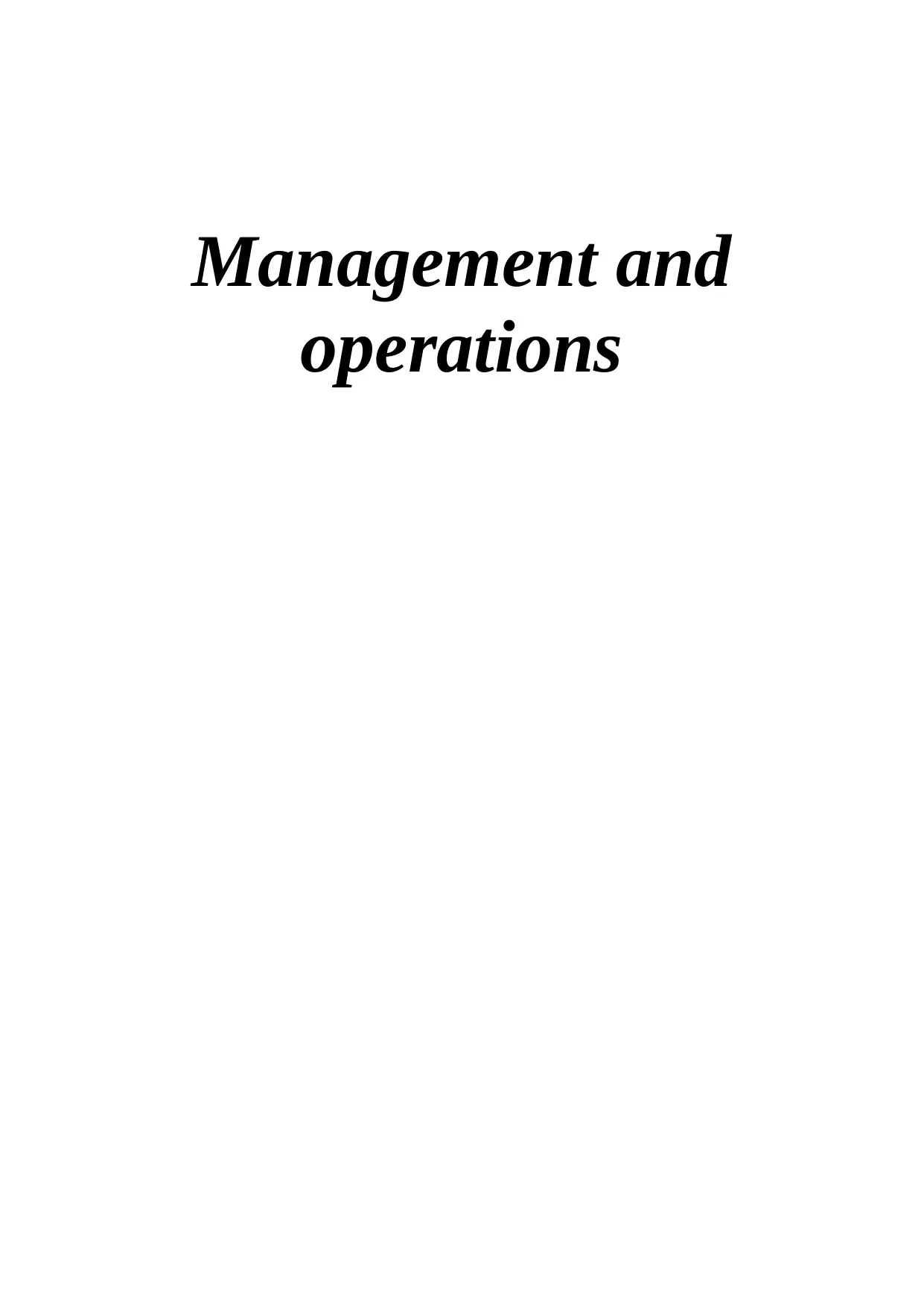
Management and
operations
operations
Paraphrase This Document
Need a fresh take? Get an instant paraphrase of this document with our AI Paraphraser
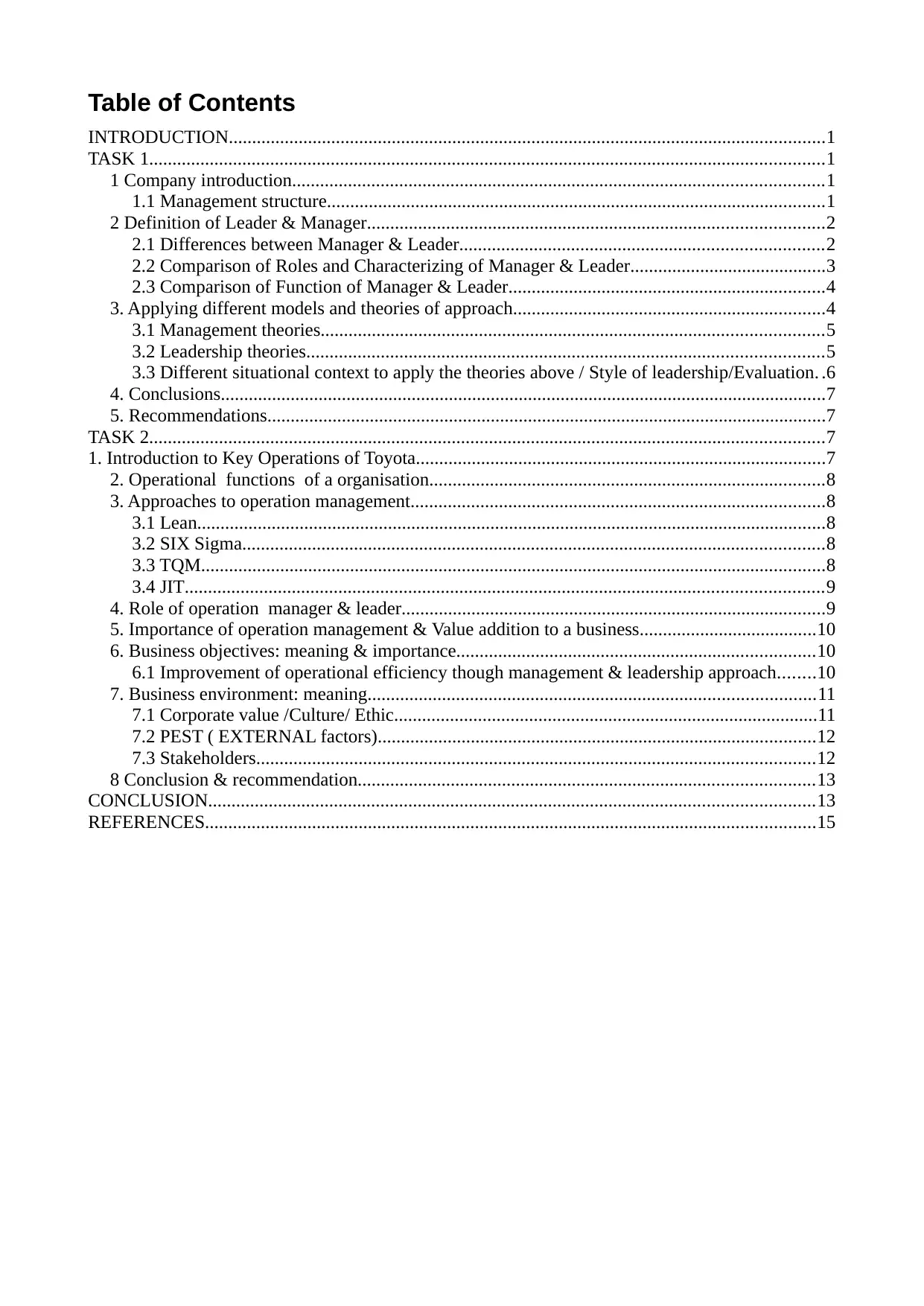
Table of Contents
INTRODUCTION................................................................................................................................1
TASK 1.................................................................................................................................................1
1 Company introduction..................................................................................................................1
1.1 Management structure...........................................................................................................1
2 Definition of Leader & Manager..................................................................................................2
2.1 Differences between Manager & Leader..............................................................................2
2.2 Comparison of Roles and Characterizing of Manager & Leader..........................................3
2.3 Comparison of Function of Manager & Leader....................................................................4
3. Applying different models and theories of approach...................................................................4
3.1 Management theories............................................................................................................5
3.2 Leadership theories...............................................................................................................5
3.3 Different situational context to apply the theories above / Style of leadership/Evaluation. .6
4. Conclusions..................................................................................................................................7
5. Recommendations........................................................................................................................7
TASK 2.................................................................................................................................................7
1. Introduction to Key Operations of Toyota........................................................................................7
2. Operational functions of a organisation.....................................................................................8
3. Approaches to operation management.........................................................................................8
3.1 Lean.......................................................................................................................................8
3.2 SIX Sigma.............................................................................................................................8
3.3 TQM......................................................................................................................................8
3.4 JIT.........................................................................................................................................9
4. Role of operation manager & leader...........................................................................................9
5. Importance of operation management & Value addition to a business......................................10
6. Business objectives: meaning & importance.............................................................................10
6.1 Improvement of operational efficiency though management & leadership approach........10
7. Business environment: meaning................................................................................................11
7.1 Corporate value /Culture/ Ethic...........................................................................................11
7.2 PEST ( EXTERNAL factors)..............................................................................................12
7.3 Stakeholders........................................................................................................................12
8 Conclusion & recommendation..................................................................................................13
CONCLUSION..................................................................................................................................13
REFERENCES...................................................................................................................................15
INTRODUCTION................................................................................................................................1
TASK 1.................................................................................................................................................1
1 Company introduction..................................................................................................................1
1.1 Management structure...........................................................................................................1
2 Definition of Leader & Manager..................................................................................................2
2.1 Differences between Manager & Leader..............................................................................2
2.2 Comparison of Roles and Characterizing of Manager & Leader..........................................3
2.3 Comparison of Function of Manager & Leader....................................................................4
3. Applying different models and theories of approach...................................................................4
3.1 Management theories............................................................................................................5
3.2 Leadership theories...............................................................................................................5
3.3 Different situational context to apply the theories above / Style of leadership/Evaluation. .6
4. Conclusions..................................................................................................................................7
5. Recommendations........................................................................................................................7
TASK 2.................................................................................................................................................7
1. Introduction to Key Operations of Toyota........................................................................................7
2. Operational functions of a organisation.....................................................................................8
3. Approaches to operation management.........................................................................................8
3.1 Lean.......................................................................................................................................8
3.2 SIX Sigma.............................................................................................................................8
3.3 TQM......................................................................................................................................8
3.4 JIT.........................................................................................................................................9
4. Role of operation manager & leader...........................................................................................9
5. Importance of operation management & Value addition to a business......................................10
6. Business objectives: meaning & importance.............................................................................10
6.1 Improvement of operational efficiency though management & leadership approach........10
7. Business environment: meaning................................................................................................11
7.1 Corporate value /Culture/ Ethic...........................................................................................11
7.2 PEST ( EXTERNAL factors)..............................................................................................12
7.3 Stakeholders........................................................................................................................12
8 Conclusion & recommendation..................................................................................................13
CONCLUSION..................................................................................................................................13
REFERENCES...................................................................................................................................15
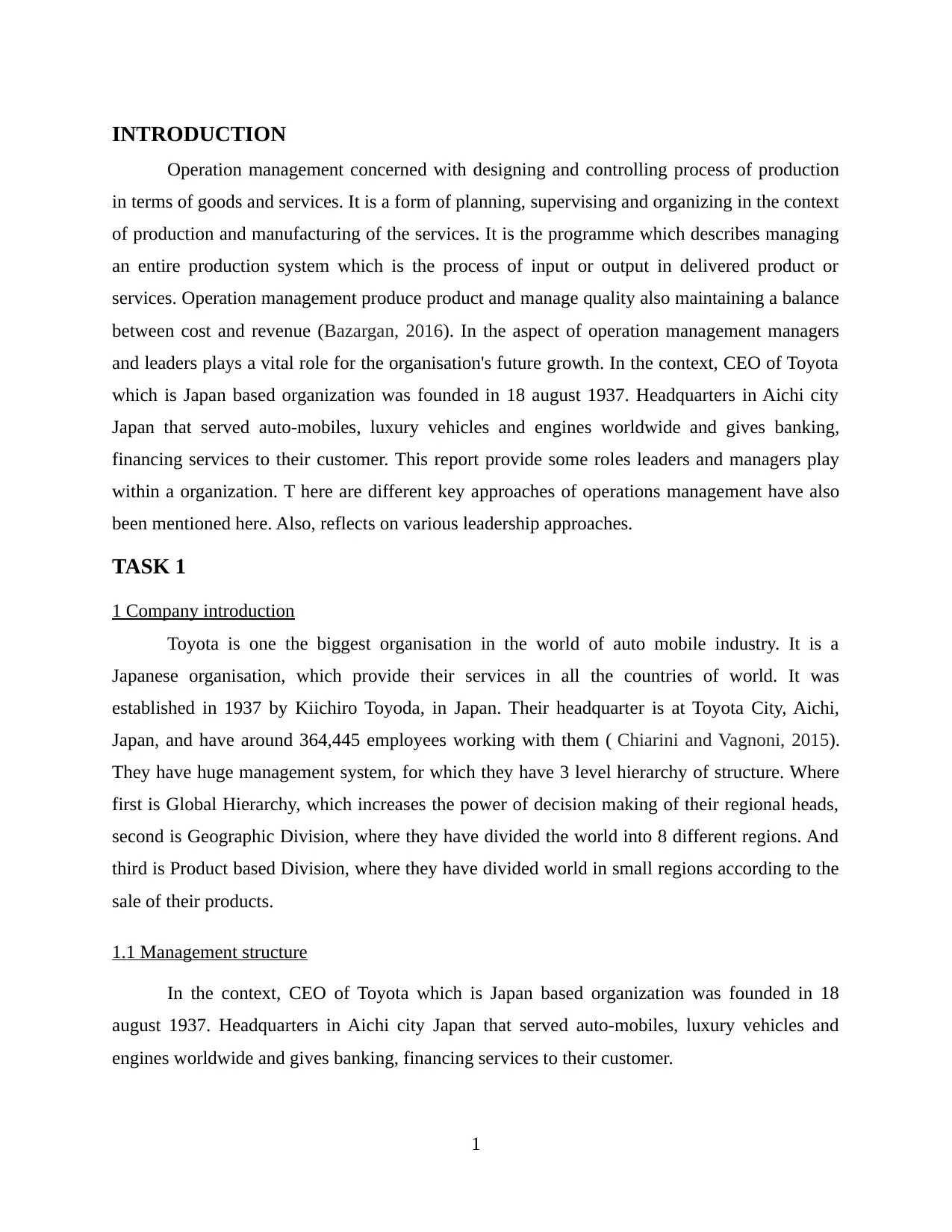
INTRODUCTION
Operation management concerned with designing and controlling process of production
in terms of goods and services. It is a form of planning, supervising and organizing in the context
of production and manufacturing of the services. It is the programme which describes managing
an entire production system which is the process of input or output in delivered product or
services. Operation management produce product and manage quality also maintaining a balance
between cost and revenue (Bazargan, 2016). In the aspect of operation management managers
and leaders plays a vital role for the organisation's future growth. In the context, CEO of Toyota
which is Japan based organization was founded in 18 august 1937. Headquarters in Aichi city
Japan that served auto-mobiles, luxury vehicles and engines worldwide and gives banking,
financing services to their customer. This report provide some roles leaders and managers play
within a organization. T here are different key approaches of operations management have also
been mentioned here. Also, reflects on various leadership approaches.
TASK 1
1 Company introduction
Toyota is one the biggest organisation in the world of auto mobile industry. It is a
Japanese organisation, which provide their services in all the countries of world. It was
established in 1937 by Kiichiro Toyoda, in Japan. Their headquarter is at Toyota City, Aichi,
Japan, and have around 364,445 employees working with them ( Chiarini and Vagnoni, 2015).
They have huge management system, for which they have 3 level hierarchy of structure. Where
first is Global Hierarchy, which increases the power of decision making of their regional heads,
second is Geographic Division, where they have divided the world into 8 different regions. And
third is Product based Division, where they have divided world in small regions according to the
sale of their products.
1.1 Management structure
In the context, CEO of Toyota which is Japan based organization was founded in 18
august 1937. Headquarters in Aichi city Japan that served auto-mobiles, luxury vehicles and
engines worldwide and gives banking, financing services to their customer.
1
Operation management concerned with designing and controlling process of production
in terms of goods and services. It is a form of planning, supervising and organizing in the context
of production and manufacturing of the services. It is the programme which describes managing
an entire production system which is the process of input or output in delivered product or
services. Operation management produce product and manage quality also maintaining a balance
between cost and revenue (Bazargan, 2016). In the aspect of operation management managers
and leaders plays a vital role for the organisation's future growth. In the context, CEO of Toyota
which is Japan based organization was founded in 18 august 1937. Headquarters in Aichi city
Japan that served auto-mobiles, luxury vehicles and engines worldwide and gives banking,
financing services to their customer. This report provide some roles leaders and managers play
within a organization. T here are different key approaches of operations management have also
been mentioned here. Also, reflects on various leadership approaches.
TASK 1
1 Company introduction
Toyota is one the biggest organisation in the world of auto mobile industry. It is a
Japanese organisation, which provide their services in all the countries of world. It was
established in 1937 by Kiichiro Toyoda, in Japan. Their headquarter is at Toyota City, Aichi,
Japan, and have around 364,445 employees working with them ( Chiarini and Vagnoni, 2015).
They have huge management system, for which they have 3 level hierarchy of structure. Where
first is Global Hierarchy, which increases the power of decision making of their regional heads,
second is Geographic Division, where they have divided the world into 8 different regions. And
third is Product based Division, where they have divided world in small regions according to the
sale of their products.
1.1 Management structure
In the context, CEO of Toyota which is Japan based organization was founded in 18
august 1937. Headquarters in Aichi city Japan that served auto-mobiles, luxury vehicles and
engines worldwide and gives banking, financing services to their customer.
1
⊘ This is a preview!⊘
Do you want full access?
Subscribe today to unlock all pages.

Trusted by 1+ million students worldwide
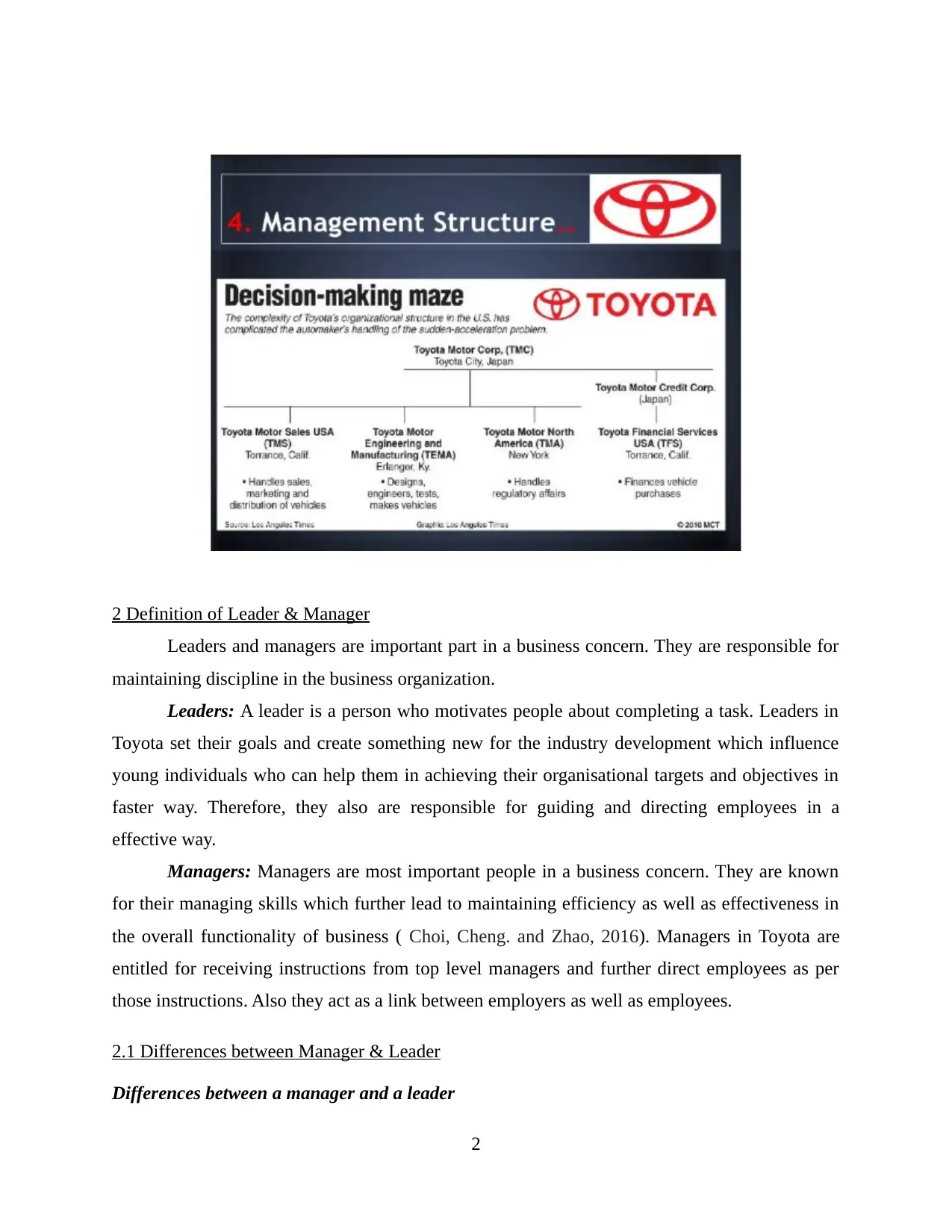
2 Definition of Leader & Manager
Leaders and managers are important part in a business concern. They are responsible for
maintaining discipline in the business organization.
Leaders: A leader is a person who motivates people about completing a task. Leaders in
Toyota set their goals and create something new for the industry development which influence
young individuals who can help them in achieving their organisational targets and objectives in
faster way. Therefore, they also are responsible for guiding and directing employees in a
effective way.
Managers: Managers are most important people in a business concern. They are known
for their managing skills which further lead to maintaining efficiency as well as effectiveness in
the overall functionality of business ( Choi, Cheng. and Zhao, 2016). Managers in Toyota are
entitled for receiving instructions from top level managers and further direct employees as per
those instructions. Also they act as a link between employers as well as employees.
2.1 Differences between Manager & Leader
Differences between a manager and a leader
2
Leaders and managers are important part in a business concern. They are responsible for
maintaining discipline in the business organization.
Leaders: A leader is a person who motivates people about completing a task. Leaders in
Toyota set their goals and create something new for the industry development which influence
young individuals who can help them in achieving their organisational targets and objectives in
faster way. Therefore, they also are responsible for guiding and directing employees in a
effective way.
Managers: Managers are most important people in a business concern. They are known
for their managing skills which further lead to maintaining efficiency as well as effectiveness in
the overall functionality of business ( Choi, Cheng. and Zhao, 2016). Managers in Toyota are
entitled for receiving instructions from top level managers and further direct employees as per
those instructions. Also they act as a link between employers as well as employees.
2.1 Differences between Manager & Leader
Differences between a manager and a leader
2
Paraphrase This Document
Need a fresh take? Get an instant paraphrase of this document with our AI Paraphraser
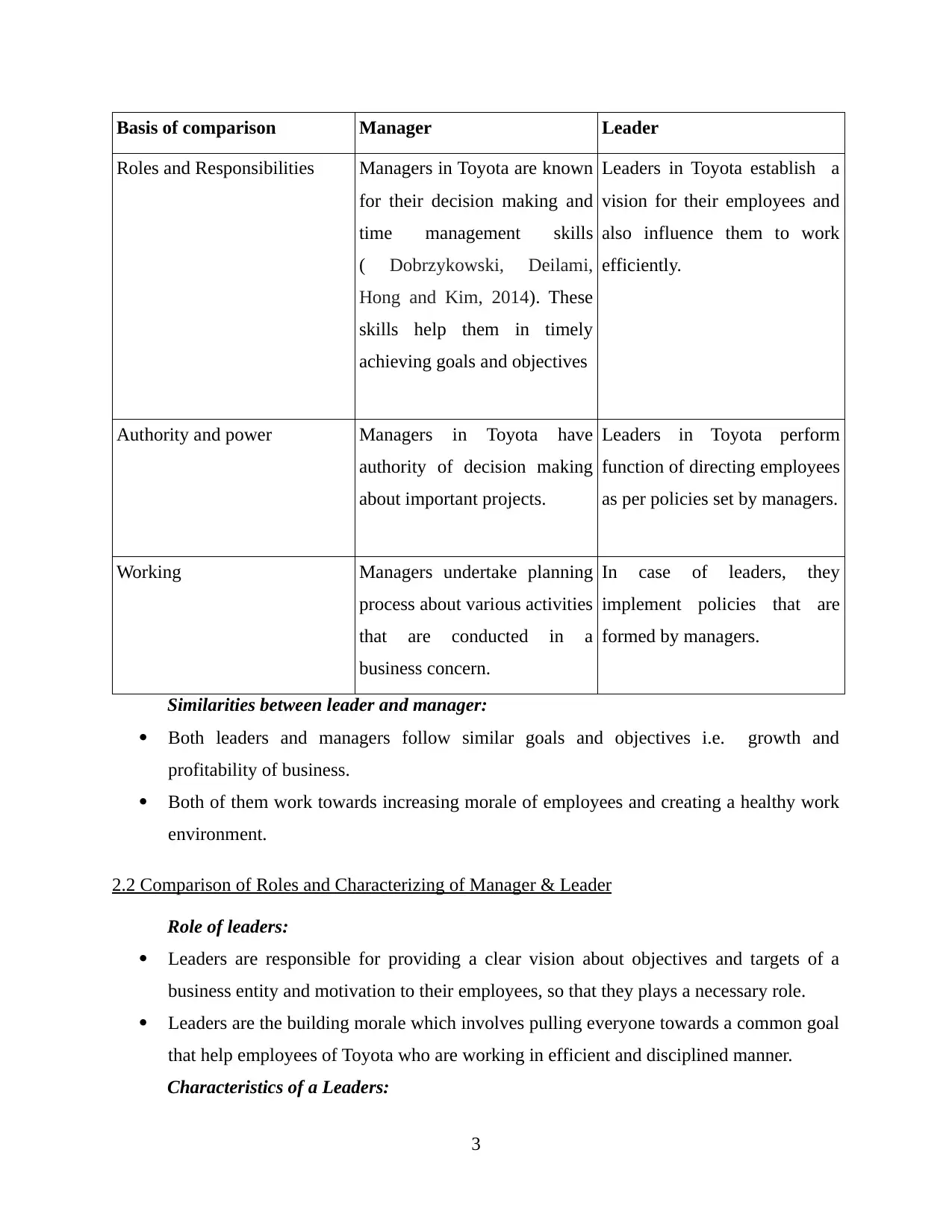
Basis of comparison Manager Leader
Roles and Responsibilities Managers in Toyota are known
for their decision making and
time management skills
( Dobrzykowski, Deilami,
Hong and Kim, 2014). These
skills help them in timely
achieving goals and objectives
Leaders in Toyota establish a
vision for their employees and
also influence them to work
efficiently.
Authority and power Managers in Toyota have
authority of decision making
about important projects.
Leaders in Toyota perform
function of directing employees
as per policies set by managers.
Working Managers undertake planning
process about various activities
that are conducted in a
business concern.
In case of leaders, they
implement policies that are
formed by managers.
Similarities between leader and manager:
Both leaders and managers follow similar goals and objectives i.e. growth and
profitability of business.
Both of them work towards increasing morale of employees and creating a healthy work
environment.
2.2 Comparison of Roles and Characterizing of Manager & Leader
Role of leaders:
Leaders are responsible for providing a clear vision about objectives and targets of a
business entity and motivation to their employees, so that they plays a necessary role.
Leaders are the building morale which involves pulling everyone towards a common goal
that help employees of Toyota who are working in efficient and disciplined manner.
Characteristics of a Leaders:
3
Roles and Responsibilities Managers in Toyota are known
for their decision making and
time management skills
( Dobrzykowski, Deilami,
Hong and Kim, 2014). These
skills help them in timely
achieving goals and objectives
Leaders in Toyota establish a
vision for their employees and
also influence them to work
efficiently.
Authority and power Managers in Toyota have
authority of decision making
about important projects.
Leaders in Toyota perform
function of directing employees
as per policies set by managers.
Working Managers undertake planning
process about various activities
that are conducted in a
business concern.
In case of leaders, they
implement policies that are
formed by managers.
Similarities between leader and manager:
Both leaders and managers follow similar goals and objectives i.e. growth and
profitability of business.
Both of them work towards increasing morale of employees and creating a healthy work
environment.
2.2 Comparison of Roles and Characterizing of Manager & Leader
Role of leaders:
Leaders are responsible for providing a clear vision about objectives and targets of a
business entity and motivation to their employees, so that they plays a necessary role.
Leaders are the building morale which involves pulling everyone towards a common goal
that help employees of Toyota who are working in efficient and disciplined manner.
Characteristics of a Leaders:
3
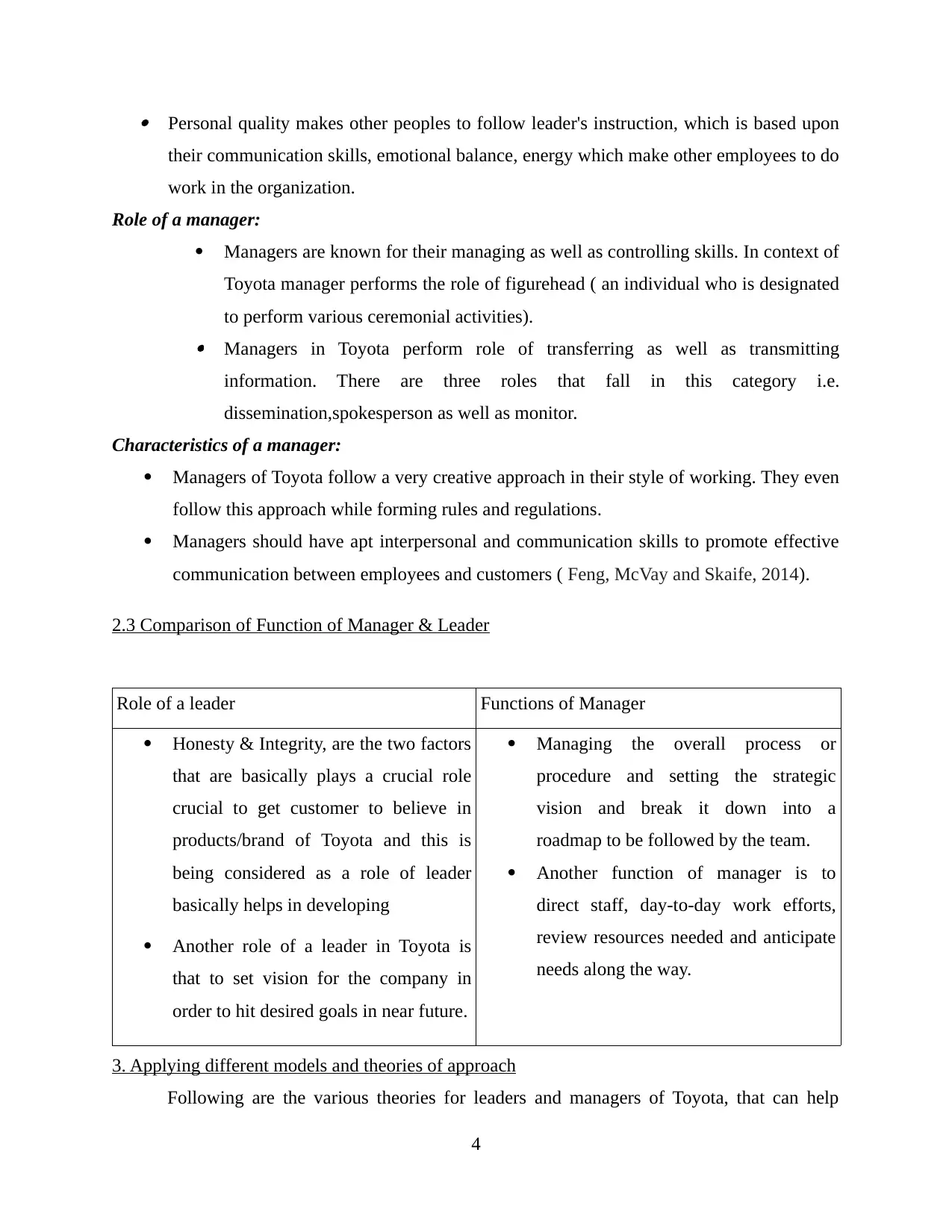
Personal quality makes other peoples to follow leader's instruction, which is based upon
their communication skills, emotional balance, energy which make other employees to do
work in the organization.
Role of a manager:
Managers are known for their managing as well as controlling skills. In context of
Toyota manager performs the role of figurehead ( an individual who is designated
to perform various ceremonial activities).
Managers in Toyota perform role of transferring as well as transmitting
information. There are three roles that fall in this category i.e.
dissemination,spokesperson as well as monitor.
Characteristics of a manager:
Managers of Toyota follow a very creative approach in their style of working. They even
follow this approach while forming rules and regulations.
Managers should have apt interpersonal and communication skills to promote effective
communication between employees and customers ( Feng, McVay and Skaife, 2014).
2.3 Comparison of Function of Manager & Leader
Role of a leader Functions of Manager
Honesty & Integrity, are the two factors
that are basically plays a crucial role
crucial to get customer to believe in
products/brand of Toyota and this is
being considered as a role of leader
basically helps in developing
Another role of a leader in Toyota is
that to set vision for the company in
order to hit desired goals in near future.
Managing the overall process or
procedure and setting the strategic
vision and break it down into a
roadmap to be followed by the team.
Another function of manager is to
direct staff, day-to-day work efforts,
review resources needed and anticipate
needs along the way.
3. Applying different models and theories of approach
Following are the various theories for leaders and managers of Toyota, that can help
4
their communication skills, emotional balance, energy which make other employees to do
work in the organization.
Role of a manager:
Managers are known for their managing as well as controlling skills. In context of
Toyota manager performs the role of figurehead ( an individual who is designated
to perform various ceremonial activities).
Managers in Toyota perform role of transferring as well as transmitting
information. There are three roles that fall in this category i.e.
dissemination,spokesperson as well as monitor.
Characteristics of a manager:
Managers of Toyota follow a very creative approach in their style of working. They even
follow this approach while forming rules and regulations.
Managers should have apt interpersonal and communication skills to promote effective
communication between employees and customers ( Feng, McVay and Skaife, 2014).
2.3 Comparison of Function of Manager & Leader
Role of a leader Functions of Manager
Honesty & Integrity, are the two factors
that are basically plays a crucial role
crucial to get customer to believe in
products/brand of Toyota and this is
being considered as a role of leader
basically helps in developing
Another role of a leader in Toyota is
that to set vision for the company in
order to hit desired goals in near future.
Managing the overall process or
procedure and setting the strategic
vision and break it down into a
roadmap to be followed by the team.
Another function of manager is to
direct staff, day-to-day work efforts,
review resources needed and anticipate
needs along the way.
3. Applying different models and theories of approach
Following are the various theories for leaders and managers of Toyota, that can help
4
⊘ This is a preview!⊘
Do you want full access?
Subscribe today to unlock all pages.

Trusted by 1+ million students worldwide
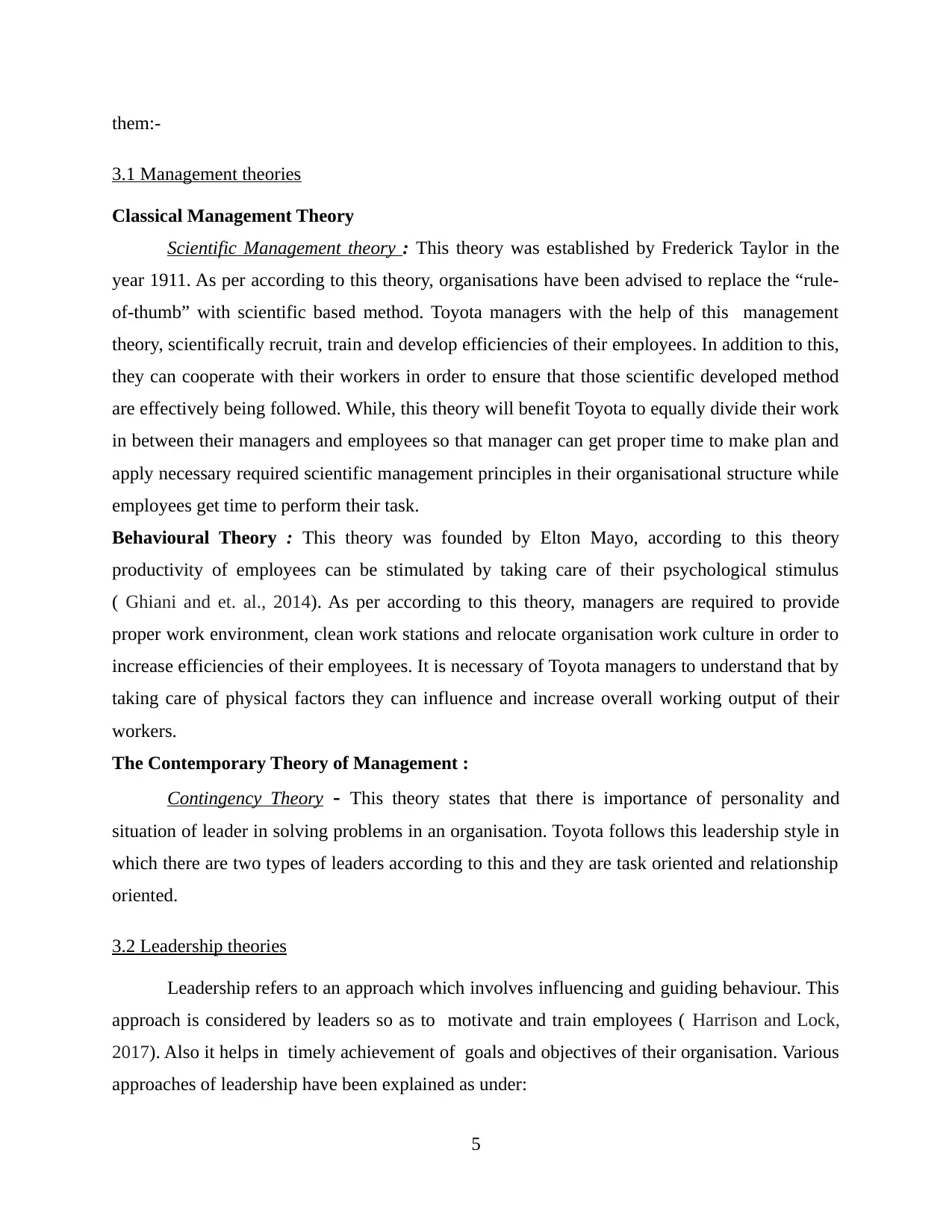
them:-
3.1 Management theories
Classical Management Theory
Scientific Management theory : This theory was established by Frederick Taylor in the
year 1911. As per according to this theory, organisations have been advised to replace the “rule-
of-thumb” with scientific based method. Toyota managers with the help of this management
theory, scientifically recruit, train and develop efficiencies of their employees. In addition to this,
they can cooperate with their workers in order to ensure that those scientific developed method
are effectively being followed. While, this theory will benefit Toyota to equally divide their work
in between their managers and employees so that manager can get proper time to make plan and
apply necessary required scientific management principles in their organisational structure while
employees get time to perform their task.
Behavioural Theory : This theory was founded by Elton Mayo, according to this theory
productivity of employees can be stimulated by taking care of their psychological stimulus
( Ghiani and et. al., 2014). As per according to this theory, managers are required to provide
proper work environment, clean work stations and relocate organisation work culture in order to
increase efficiencies of their employees. It is necessary of Toyota managers to understand that by
taking care of physical factors they can influence and increase overall working output of their
workers.
The Contemporary Theory of Management :
Contingency Theory - This theory states that there is importance of personality and
situation of leader in solving problems in an organisation. Toyota follows this leadership style in
which there are two types of leaders according to this and they are task oriented and relationship
oriented.
3.2 Leadership theories
Leadership refers to an approach which involves influencing and guiding behaviour. This
approach is considered by leaders so as to motivate and train employees ( Harrison and Lock,
2017). Also it helps in timely achievement of goals and objectives of their organisation. Various
approaches of leadership have been explained as under:
5
3.1 Management theories
Classical Management Theory
Scientific Management theory : This theory was established by Frederick Taylor in the
year 1911. As per according to this theory, organisations have been advised to replace the “rule-
of-thumb” with scientific based method. Toyota managers with the help of this management
theory, scientifically recruit, train and develop efficiencies of their employees. In addition to this,
they can cooperate with their workers in order to ensure that those scientific developed method
are effectively being followed. While, this theory will benefit Toyota to equally divide their work
in between their managers and employees so that manager can get proper time to make plan and
apply necessary required scientific management principles in their organisational structure while
employees get time to perform their task.
Behavioural Theory : This theory was founded by Elton Mayo, according to this theory
productivity of employees can be stimulated by taking care of their psychological stimulus
( Ghiani and et. al., 2014). As per according to this theory, managers are required to provide
proper work environment, clean work stations and relocate organisation work culture in order to
increase efficiencies of their employees. It is necessary of Toyota managers to understand that by
taking care of physical factors they can influence and increase overall working output of their
workers.
The Contemporary Theory of Management :
Contingency Theory - This theory states that there is importance of personality and
situation of leader in solving problems in an organisation. Toyota follows this leadership style in
which there are two types of leaders according to this and they are task oriented and relationship
oriented.
3.2 Leadership theories
Leadership refers to an approach which involves influencing and guiding behaviour. This
approach is considered by leaders so as to motivate and train employees ( Harrison and Lock,
2017). Also it helps in timely achievement of goals and objectives of their organisation. Various
approaches of leadership have been explained as under:
5
Paraphrase This Document
Need a fresh take? Get an instant paraphrase of this document with our AI Paraphraser
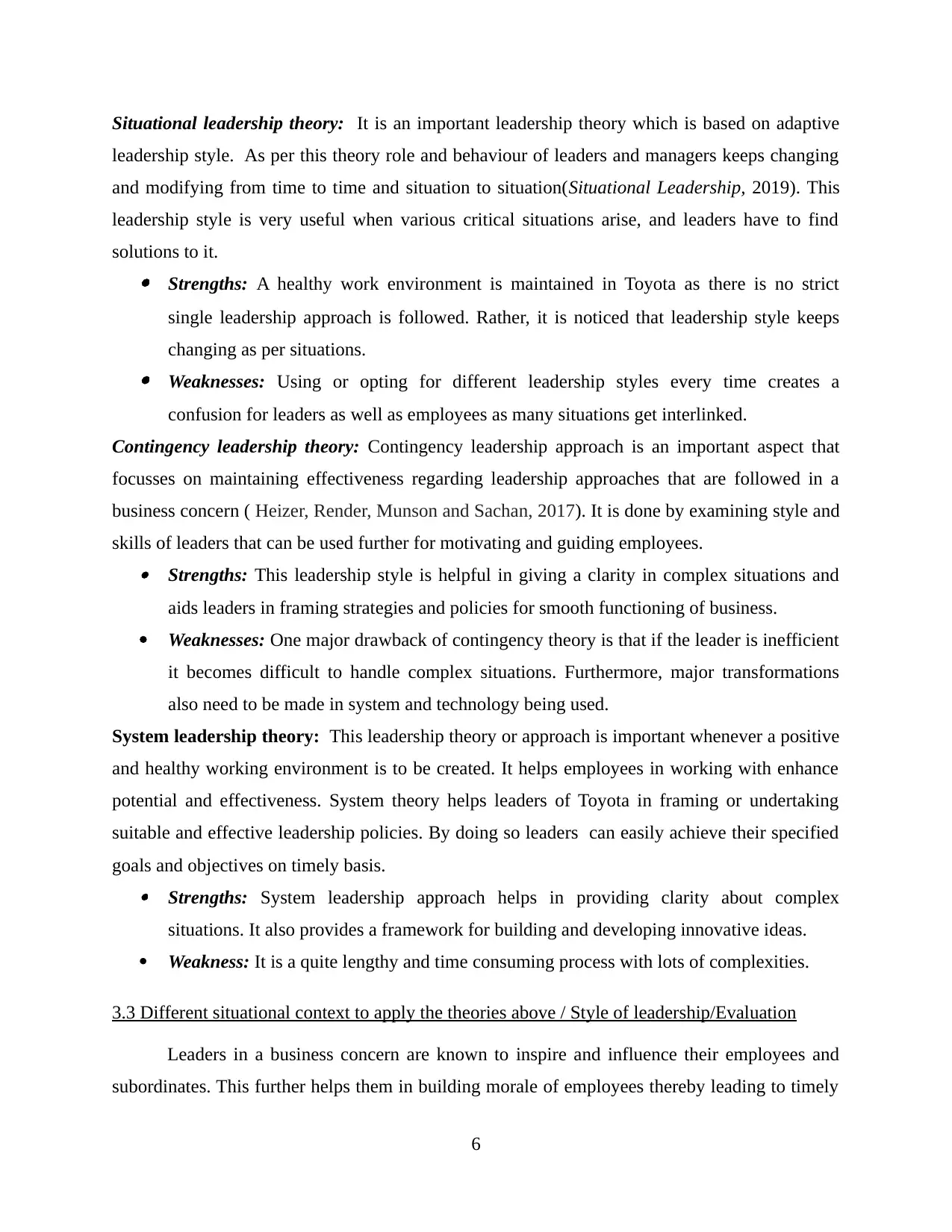
Situational leadership theory: It is an important leadership theory which is based on adaptive
leadership style. As per this theory role and behaviour of leaders and managers keeps changing
and modifying from time to time and situation to situation(Situational Leadership, 2019). This
leadership style is very useful when various critical situations arise, and leaders have to find
solutions to it. Strengths: A healthy work environment is maintained in Toyota as there is no strict
single leadership approach is followed. Rather, it is noticed that leadership style keeps
changing as per situations. Weaknesses: Using or opting for different leadership styles every time creates a
confusion for leaders as well as employees as many situations get interlinked.
Contingency leadership theory: Contingency leadership approach is an important aspect that
focusses on maintaining effectiveness regarding leadership approaches that are followed in a
business concern ( Heizer, Render, Munson and Sachan, 2017). It is done by examining style and
skills of leaders that can be used further for motivating and guiding employees. Strengths: This leadership style is helpful in giving a clarity in complex situations and
aids leaders in framing strategies and policies for smooth functioning of business.
Weaknesses: One major drawback of contingency theory is that if the leader is inefficient
it becomes difficult to handle complex situations. Furthermore, major transformations
also need to be made in system and technology being used.
System leadership theory: This leadership theory or approach is important whenever a positive
and healthy working environment is to be created. It helps employees in working with enhance
potential and effectiveness. System theory helps leaders of Toyota in framing or undertaking
suitable and effective leadership policies. By doing so leaders can easily achieve their specified
goals and objectives on timely basis. Strengths: System leadership approach helps in providing clarity about complex
situations. It also provides a framework for building and developing innovative ideas.
Weakness: It is a quite lengthy and time consuming process with lots of complexities.
3.3 Different situational context to apply the theories above / Style of leadership/Evaluation
Leaders in a business concern are known to inspire and influence their employees and
subordinates. This further helps them in building morale of employees thereby leading to timely
6
leadership style. As per this theory role and behaviour of leaders and managers keeps changing
and modifying from time to time and situation to situation(Situational Leadership, 2019). This
leadership style is very useful when various critical situations arise, and leaders have to find
solutions to it. Strengths: A healthy work environment is maintained in Toyota as there is no strict
single leadership approach is followed. Rather, it is noticed that leadership style keeps
changing as per situations. Weaknesses: Using or opting for different leadership styles every time creates a
confusion for leaders as well as employees as many situations get interlinked.
Contingency leadership theory: Contingency leadership approach is an important aspect that
focusses on maintaining effectiveness regarding leadership approaches that are followed in a
business concern ( Heizer, Render, Munson and Sachan, 2017). It is done by examining style and
skills of leaders that can be used further for motivating and guiding employees. Strengths: This leadership style is helpful in giving a clarity in complex situations and
aids leaders in framing strategies and policies for smooth functioning of business.
Weaknesses: One major drawback of contingency theory is that if the leader is inefficient
it becomes difficult to handle complex situations. Furthermore, major transformations
also need to be made in system and technology being used.
System leadership theory: This leadership theory or approach is important whenever a positive
and healthy working environment is to be created. It helps employees in working with enhance
potential and effectiveness. System theory helps leaders of Toyota in framing or undertaking
suitable and effective leadership policies. By doing so leaders can easily achieve their specified
goals and objectives on timely basis. Strengths: System leadership approach helps in providing clarity about complex
situations. It also provides a framework for building and developing innovative ideas.
Weakness: It is a quite lengthy and time consuming process with lots of complexities.
3.3 Different situational context to apply the theories above / Style of leadership/Evaluation
Leaders in a business concern are known to inspire and influence their employees and
subordinates. This further helps them in building morale of employees thereby leading to timely
6
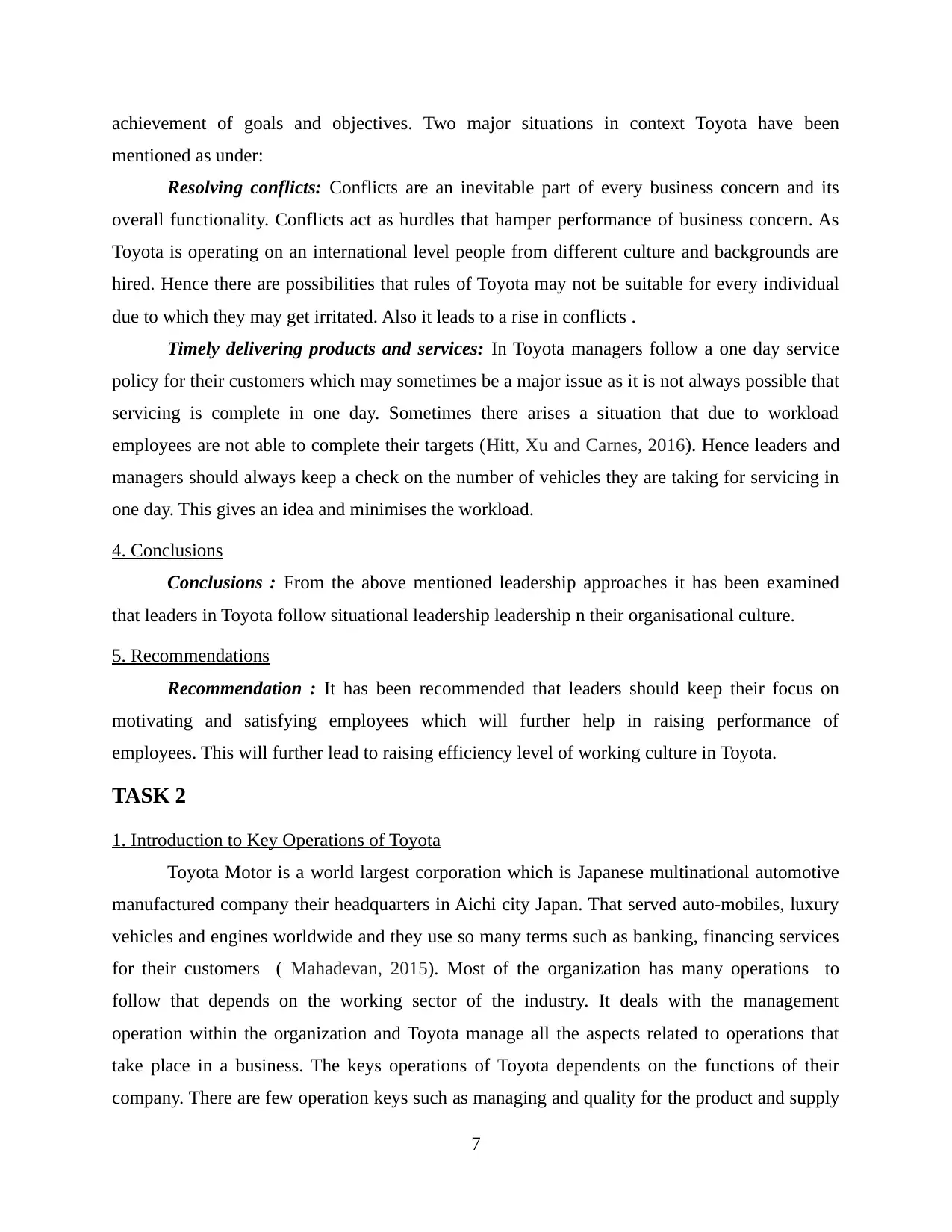
achievement of goals and objectives. Two major situations in context Toyota have been
mentioned as under:
Resolving conflicts: Conflicts are an inevitable part of every business concern and its
overall functionality. Conflicts act as hurdles that hamper performance of business concern. As
Toyota is operating on an international level people from different culture and backgrounds are
hired. Hence there are possibilities that rules of Toyota may not be suitable for every individual
due to which they may get irritated. Also it leads to a rise in conflicts .
Timely delivering products and services: In Toyota managers follow a one day service
policy for their customers which may sometimes be a major issue as it is not always possible that
servicing is complete in one day. Sometimes there arises a situation that due to workload
employees are not able to complete their targets (Hitt, Xu and Carnes, 2016). Hence leaders and
managers should always keep a check on the number of vehicles they are taking for servicing in
one day. This gives an idea and minimises the workload.
4. Conclusions
Conclusions : From the above mentioned leadership approaches it has been examined
that leaders in Toyota follow situational leadership leadership n their organisational culture.
5. Recommendations
Recommendation : It has been recommended that leaders should keep their focus on
motivating and satisfying employees which will further help in raising performance of
employees. This will further lead to raising efficiency level of working culture in Toyota.
TASK 2
1. Introduction to Key Operations of Toyota
Toyota Motor is a world largest corporation which is Japanese multinational automotive
manufactured company their headquarters in Aichi city Japan. That served auto-mobiles, luxury
vehicles and engines worldwide and they use so many terms such as banking, financing services
for their customers ( Mahadevan, 2015). Most of the organization has many operations to
follow that depends on the working sector of the industry. It deals with the management
operation within the organization and Toyota manage all the aspects related to operations that
take place in a business. The keys operations of Toyota dependents on the functions of their
company. There are few operation keys such as managing and quality for the product and supply
7
mentioned as under:
Resolving conflicts: Conflicts are an inevitable part of every business concern and its
overall functionality. Conflicts act as hurdles that hamper performance of business concern. As
Toyota is operating on an international level people from different culture and backgrounds are
hired. Hence there are possibilities that rules of Toyota may not be suitable for every individual
due to which they may get irritated. Also it leads to a rise in conflicts .
Timely delivering products and services: In Toyota managers follow a one day service
policy for their customers which may sometimes be a major issue as it is not always possible that
servicing is complete in one day. Sometimes there arises a situation that due to workload
employees are not able to complete their targets (Hitt, Xu and Carnes, 2016). Hence leaders and
managers should always keep a check on the number of vehicles they are taking for servicing in
one day. This gives an idea and minimises the workload.
4. Conclusions
Conclusions : From the above mentioned leadership approaches it has been examined
that leaders in Toyota follow situational leadership leadership n their organisational culture.
5. Recommendations
Recommendation : It has been recommended that leaders should keep their focus on
motivating and satisfying employees which will further help in raising performance of
employees. This will further lead to raising efficiency level of working culture in Toyota.
TASK 2
1. Introduction to Key Operations of Toyota
Toyota Motor is a world largest corporation which is Japanese multinational automotive
manufactured company their headquarters in Aichi city Japan. That served auto-mobiles, luxury
vehicles and engines worldwide and they use so many terms such as banking, financing services
for their customers ( Mahadevan, 2015). Most of the organization has many operations to
follow that depends on the working sector of the industry. It deals with the management
operation within the organization and Toyota manage all the aspects related to operations that
take place in a business. The keys operations of Toyota dependents on the functions of their
company. There are few operation keys such as managing and quality for the product and supply
7
⊘ This is a preview!⊘
Do you want full access?
Subscribe today to unlock all pages.

Trusted by 1+ million students worldwide
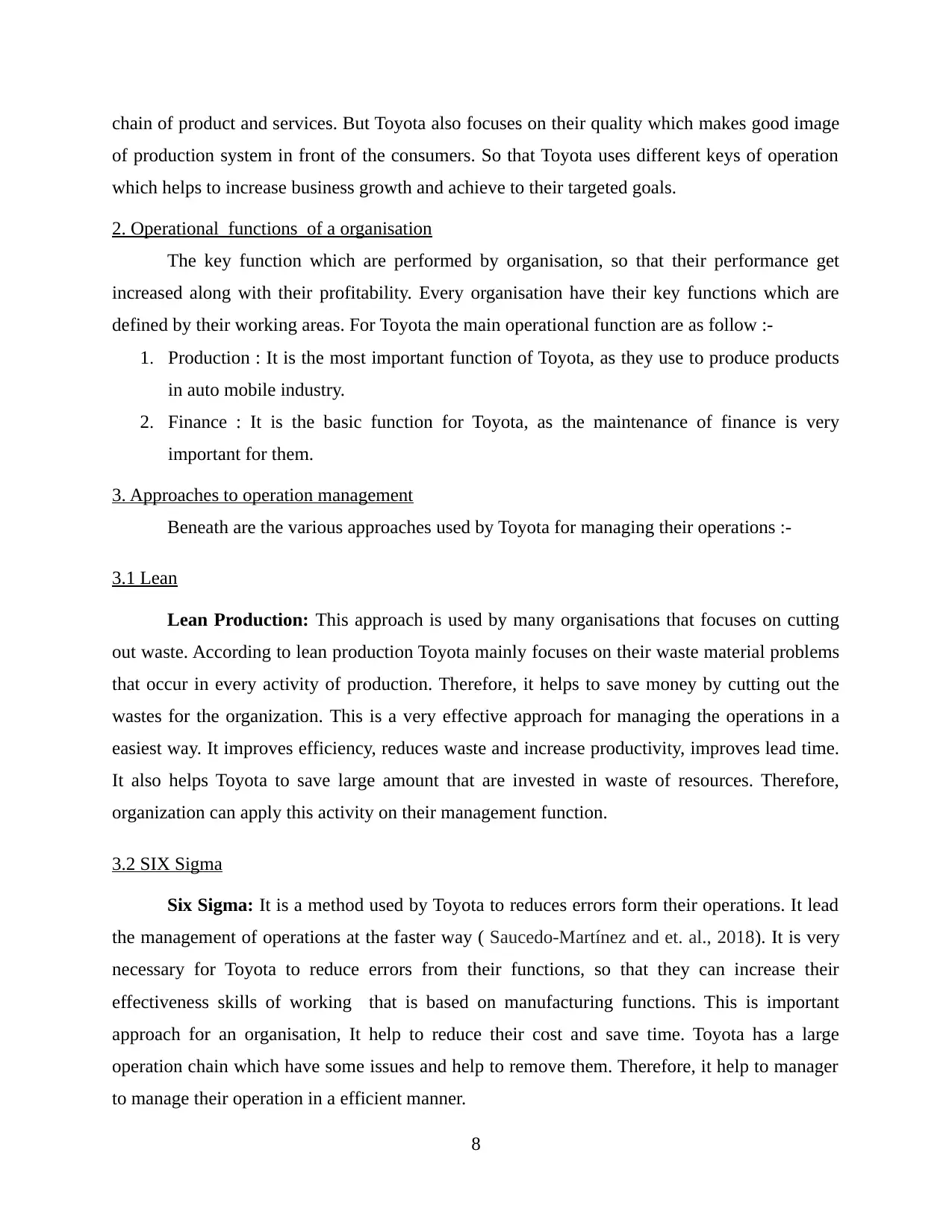
chain of product and services. But Toyota also focuses on their quality which makes good image
of production system in front of the consumers. So that Toyota uses different keys of operation
which helps to increase business growth and achieve to their targeted goals.
2. Operational functions of a organisation
The key function which are performed by organisation, so that their performance get
increased along with their profitability. Every organisation have their key functions which are
defined by their working areas. For Toyota the main operational function are as follow :-
1. Production : It is the most important function of Toyota, as they use to produce products
in auto mobile industry.
2. Finance : It is the basic function for Toyota, as the maintenance of finance is very
important for them.
3. Approaches to operation management
Beneath are the various approaches used by Toyota for managing their operations :-
3.1 Lean
Lean Production: This approach is used by many organisations that focuses on cutting
out waste. According to lean production Toyota mainly focuses on their waste material problems
that occur in every activity of production. Therefore, it helps to save money by cutting out the
wastes for the organization. This is a very effective approach for managing the operations in a
easiest way. It improves efficiency, reduces waste and increase productivity, improves lead time.
It also helps Toyota to save large amount that are invested in waste of resources. Therefore,
organization can apply this activity on their management function.
3.2 SIX Sigma
Six Sigma: It is a method used by Toyota to reduces errors form their operations. It lead
the management of operations at the faster way ( Saucedo-Martínez and et. al., 2018). It is very
necessary for Toyota to reduce errors from their functions, so that they can increase their
effectiveness skills of working that is based on manufacturing functions. This is important
approach for an organisation, It help to reduce their cost and save time. Toyota has a large
operation chain which have some issues and help to remove them. Therefore, it help to manager
to manage their operation in a efficient manner.
8
of production system in front of the consumers. So that Toyota uses different keys of operation
which helps to increase business growth and achieve to their targeted goals.
2. Operational functions of a organisation
The key function which are performed by organisation, so that their performance get
increased along with their profitability. Every organisation have their key functions which are
defined by their working areas. For Toyota the main operational function are as follow :-
1. Production : It is the most important function of Toyota, as they use to produce products
in auto mobile industry.
2. Finance : It is the basic function for Toyota, as the maintenance of finance is very
important for them.
3. Approaches to operation management
Beneath are the various approaches used by Toyota for managing their operations :-
3.1 Lean
Lean Production: This approach is used by many organisations that focuses on cutting
out waste. According to lean production Toyota mainly focuses on their waste material problems
that occur in every activity of production. Therefore, it helps to save money by cutting out the
wastes for the organization. This is a very effective approach for managing the operations in a
easiest way. It improves efficiency, reduces waste and increase productivity, improves lead time.
It also helps Toyota to save large amount that are invested in waste of resources. Therefore,
organization can apply this activity on their management function.
3.2 SIX Sigma
Six Sigma: It is a method used by Toyota to reduces errors form their operations. It lead
the management of operations at the faster way ( Saucedo-Martínez and et. al., 2018). It is very
necessary for Toyota to reduce errors from their functions, so that they can increase their
effectiveness skills of working that is based on manufacturing functions. This is important
approach for an organisation, It help to reduce their cost and save time. Toyota has a large
operation chain which have some issues and help to remove them. Therefore, it help to manager
to manage their operation in a efficient manner.
8
Paraphrase This Document
Need a fresh take? Get an instant paraphrase of this document with our AI Paraphraser
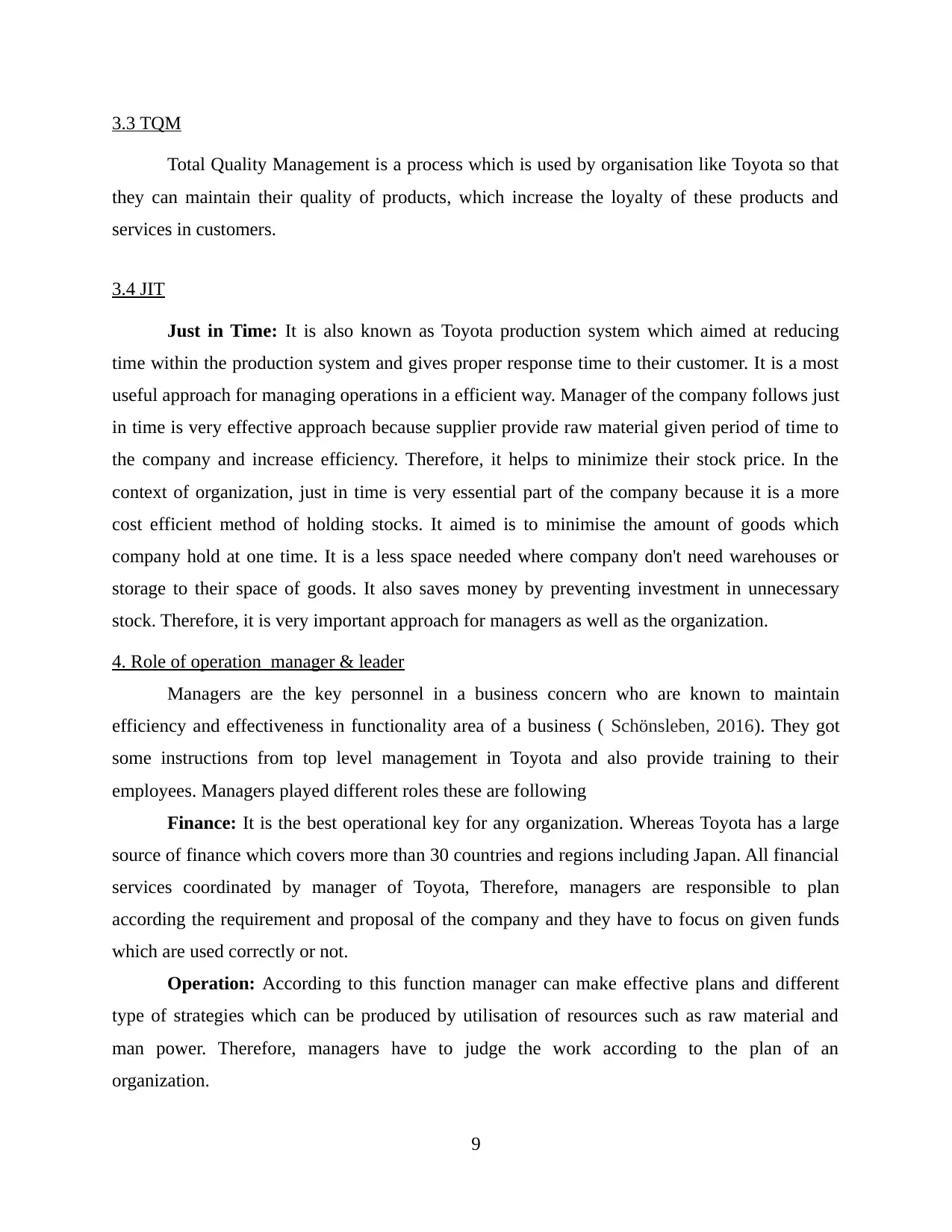
3.3 TQM
Total Quality Management is a process which is used by organisation like Toyota so that
they can maintain their quality of products, which increase the loyalty of these products and
services in customers.
3.4 JIT
Just in Time: It is also known as Toyota production system which aimed at reducing
time within the production system and gives proper response time to their customer. It is a most
useful approach for managing operations in a efficient way. Manager of the company follows just
in time is very effective approach because supplier provide raw material given period of time to
the company and increase efficiency. Therefore, it helps to minimize their stock price. In the
context of organization, just in time is very essential part of the company because it is a more
cost efficient method of holding stocks. It aimed is to minimise the amount of goods which
company hold at one time. It is a less space needed where company don't need warehouses or
storage to their space of goods. It also saves money by preventing investment in unnecessary
stock. Therefore, it is very important approach for managers as well as the organization.
4. Role of operation manager & leader
Managers are the key personnel in a business concern who are known to maintain
efficiency and effectiveness in functionality area of a business ( Schönsleben, 2016). They got
some instructions from top level management in Toyota and also provide training to their
employees. Managers played different roles these are following
Finance: It is the best operational key for any organization. Whereas Toyota has a large
source of finance which covers more than 30 countries and regions including Japan. All financial
services coordinated by manager of Toyota, Therefore, managers are responsible to plan
according the requirement and proposal of the company and they have to focus on given funds
which are used correctly or not.
Operation: According to this function manager can make effective plans and different
type of strategies which can be produced by utilisation of resources such as raw material and
man power. Therefore, managers have to judge the work according to the plan of an
organization.
9
Total Quality Management is a process which is used by organisation like Toyota so that
they can maintain their quality of products, which increase the loyalty of these products and
services in customers.
3.4 JIT
Just in Time: It is also known as Toyota production system which aimed at reducing
time within the production system and gives proper response time to their customer. It is a most
useful approach for managing operations in a efficient way. Manager of the company follows just
in time is very effective approach because supplier provide raw material given period of time to
the company and increase efficiency. Therefore, it helps to minimize their stock price. In the
context of organization, just in time is very essential part of the company because it is a more
cost efficient method of holding stocks. It aimed is to minimise the amount of goods which
company hold at one time. It is a less space needed where company don't need warehouses or
storage to their space of goods. It also saves money by preventing investment in unnecessary
stock. Therefore, it is very important approach for managers as well as the organization.
4. Role of operation manager & leader
Managers are the key personnel in a business concern who are known to maintain
efficiency and effectiveness in functionality area of a business ( Schönsleben, 2016). They got
some instructions from top level management in Toyota and also provide training to their
employees. Managers played different roles these are following
Finance: It is the best operational key for any organization. Whereas Toyota has a large
source of finance which covers more than 30 countries and regions including Japan. All financial
services coordinated by manager of Toyota, Therefore, managers are responsible to plan
according the requirement and proposal of the company and they have to focus on given funds
which are used correctly or not.
Operation: According to this function manager can make effective plans and different
type of strategies which can be produced by utilisation of resources such as raw material and
man power. Therefore, managers have to judge the work according to the plan of an
organization.
9
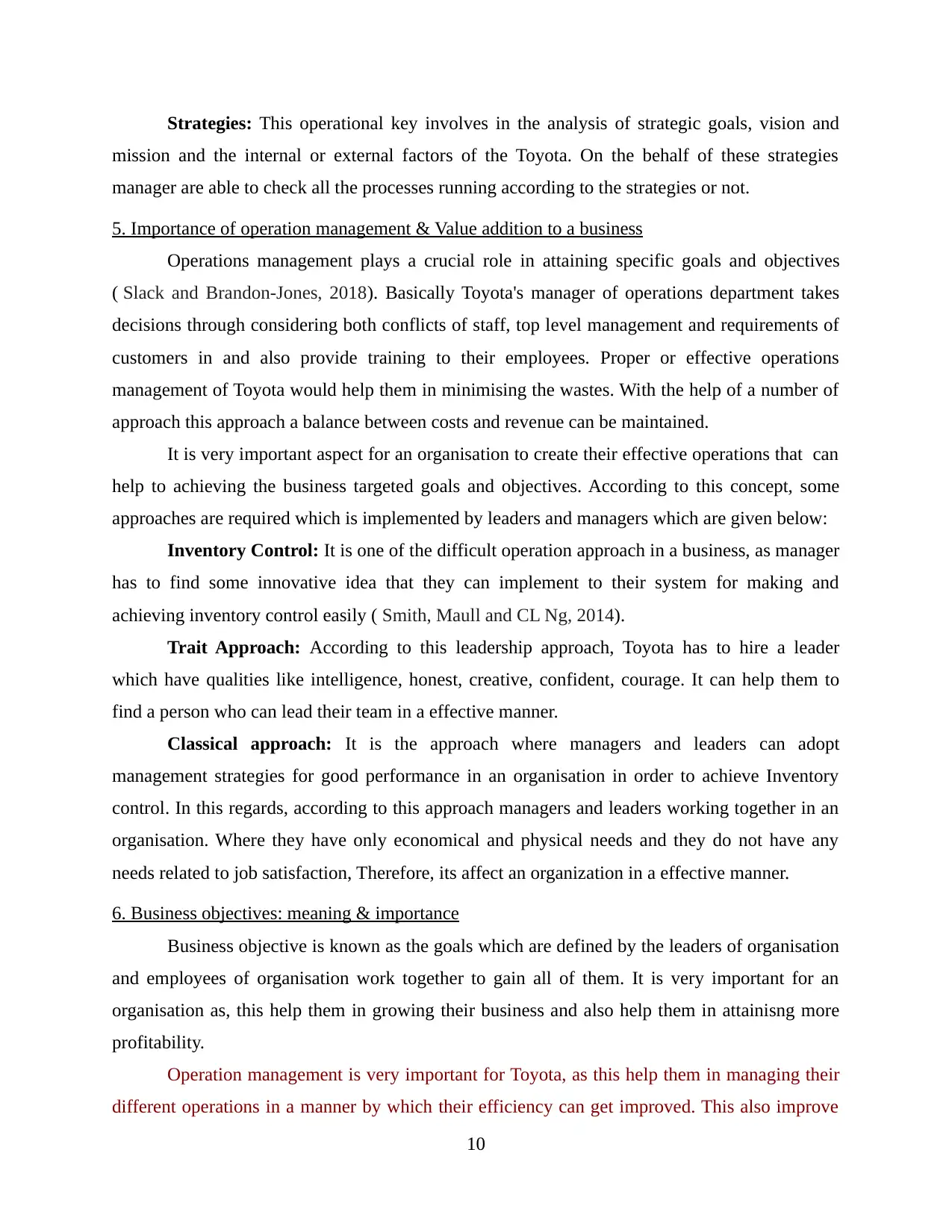
Strategies: This operational key involves in the analysis of strategic goals, vision and
mission and the internal or external factors of the Toyota. On the behalf of these strategies
manager are able to check all the processes running according to the strategies or not.
5. Importance of operation management & Value addition to a business
Operations management plays a crucial role in attaining specific goals and objectives
( Slack and Brandon-Jones, 2018). Basically Toyota's manager of operations department takes
decisions through considering both conflicts of staff, top level management and requirements of
customers in and also provide training to their employees. Proper or effective operations
management of Toyota would help them in minimising the wastes. With the help of a number of
approach this approach a balance between costs and revenue can be maintained.
It is very important aspect for an organisation to create their effective operations that can
help to achieving the business targeted goals and objectives. According to this concept, some
approaches are required which is implemented by leaders and managers which are given below:
Inventory Control: It is one of the difficult operation approach in a business, as manager
has to find some innovative idea that they can implement to their system for making and
achieving inventory control easily ( Smith, Maull and CL Ng, 2014).
Trait Approach: According to this leadership approach, Toyota has to hire a leader
which have qualities like intelligence, honest, creative, confident, courage. It can help them to
find a person who can lead their team in a effective manner.
Classical approach: It is the approach where managers and leaders can adopt
management strategies for good performance in an organisation in order to achieve Inventory
control. In this regards, according to this approach managers and leaders working together in an
organisation. Where they have only economical and physical needs and they do not have any
needs related to job satisfaction, Therefore, its affect an organization in a effective manner.
6. Business objectives: meaning & importance
Business objective is known as the goals which are defined by the leaders of organisation
and employees of organisation work together to gain all of them. It is very important for an
organisation as, this help them in growing their business and also help them in attainisng more
profitability.
Operation management is very important for Toyota, as this help them in managing their
different operations in a manner by which their efficiency can get improved. This also improve
10
mission and the internal or external factors of the Toyota. On the behalf of these strategies
manager are able to check all the processes running according to the strategies or not.
5. Importance of operation management & Value addition to a business
Operations management plays a crucial role in attaining specific goals and objectives
( Slack and Brandon-Jones, 2018). Basically Toyota's manager of operations department takes
decisions through considering both conflicts of staff, top level management and requirements of
customers in and also provide training to their employees. Proper or effective operations
management of Toyota would help them in minimising the wastes. With the help of a number of
approach this approach a balance between costs and revenue can be maintained.
It is very important aspect for an organisation to create their effective operations that can
help to achieving the business targeted goals and objectives. According to this concept, some
approaches are required which is implemented by leaders and managers which are given below:
Inventory Control: It is one of the difficult operation approach in a business, as manager
has to find some innovative idea that they can implement to their system for making and
achieving inventory control easily ( Smith, Maull and CL Ng, 2014).
Trait Approach: According to this leadership approach, Toyota has to hire a leader
which have qualities like intelligence, honest, creative, confident, courage. It can help them to
find a person who can lead their team in a effective manner.
Classical approach: It is the approach where managers and leaders can adopt
management strategies for good performance in an organisation in order to achieve Inventory
control. In this regards, according to this approach managers and leaders working together in an
organisation. Where they have only economical and physical needs and they do not have any
needs related to job satisfaction, Therefore, its affect an organization in a effective manner.
6. Business objectives: meaning & importance
Business objective is known as the goals which are defined by the leaders of organisation
and employees of organisation work together to gain all of them. It is very important for an
organisation as, this help them in growing their business and also help them in attainisng more
profitability.
Operation management is very important for Toyota, as this help them in managing their
different operations in a manner by which their efficiency can get improved. This also improve
10
⊘ This is a preview!⊘
Do you want full access?
Subscribe today to unlock all pages.

Trusted by 1+ million students worldwide
1 out of 18
Related Documents
Your All-in-One AI-Powered Toolkit for Academic Success.
+13062052269
info@desklib.com
Available 24*7 on WhatsApp / Email
![[object Object]](/_next/static/media/star-bottom.7253800d.svg)
Unlock your academic potential
Copyright © 2020–2025 A2Z Services. All Rights Reserved. Developed and managed by ZUCOL.





